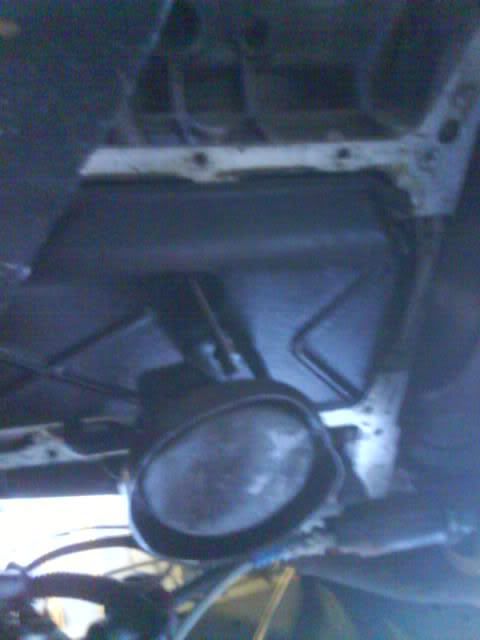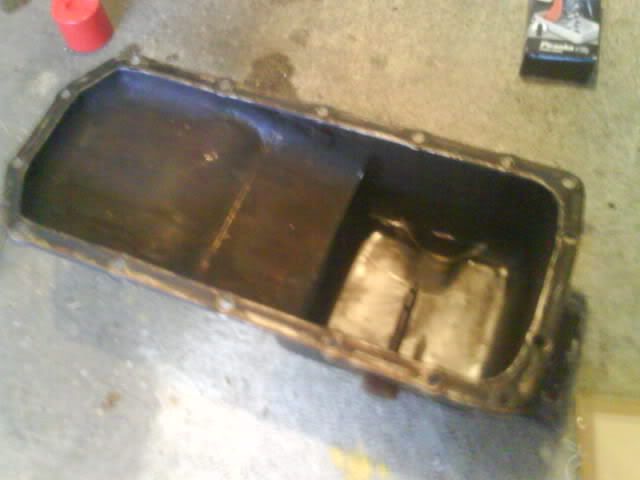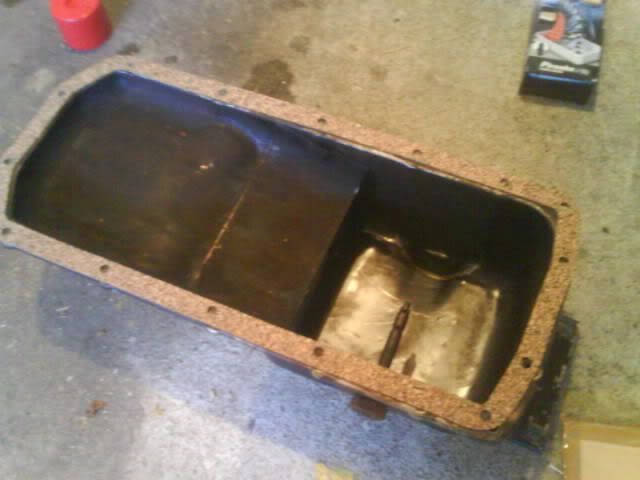Sump Removal
Moderator: phpBB2 - Administrators
- Andy515666
- Forum Contributor

- Posts: 78
- Joined: Mon Nov 27, 2006 10:59 pm
Sump Removal
HI everyone
Has anyone removed a sump from an SD1 without removing the motor?
I have to take mine off and just wanted to put it out there becaue i REALLY do not want the motor out ..................AGAIN!
Cheers
Andy
Has anyone removed a sump from an SD1 without removing the motor?
I have to take mine off and just wanted to put it out there becaue i REALLY do not want the motor out ..................AGAIN!
Cheers
Andy
Chur Bro
- Andy515666
- Forum Contributor

- Posts: 78
- Joined: Mon Nov 27, 2006 10:59 pm
Hippyvabw wrote:Why do you have to take it off?
Dunno about the sd1, but I would rather have the engine out than f**k about under the car with an mgb. depends what you want to do i guess.
Wanting to take it off because it is leaking. I need to re-gasket it
I should be able to work under the car but the sub frame is in the way!
stink
Chur Bro
Once you have removed the sump and cleaned off all that remains of the old gasket, don't use another cork or cardboard gasket.
After about 1998, all the Rover engines in the Land Rovers and Range Rovers used metal to metal fitting, with just a layer of sealant between the sump and block. No more gaskets!
My new 4.6 litre engine has my P6B sump fitted in exactly this way, and no leaks!
I recall removing the sump off my P6B some years ago. Used a large g clamp to grab gently either side of the sump, then pulled it down and off. Very fiddly with the cross member in the way. Took me just about all day if I recall. No fun at all!
Ron.
After about 1998, all the Rover engines in the Land Rovers and Range Rovers used metal to metal fitting, with just a layer of sealant between the sump and block. No more gaskets!
My new 4.6 litre engine has my P6B sump fitted in exactly this way, and no leaks!
I recall removing the sump off my P6B some years ago. Used a large g clamp to grab gently either side of the sump, then pulled it down and off. Very fiddly with the cross member in the way. Took me just about all day if I recall. No fun at all!
Ron.
4.6 Rover 3500 P6B
-
ramon alban
- Knows His Stuff

- Posts: 667
- Joined: Fri Nov 17, 2006 11:22 pm
- Location: Bedford UK
- Contact:
Re: Sump Removal
Hello Andy. I believe the way to deal with this problem is to remove the two main engine mounting bolts and any restraining attachments (not many if any)and jack up the engine in the front pulley just about an inch or so, sufficient to allow access above the steerring rack to the sump bolts and removal of the sump tray. I think this is covered in one of the SD1 workshop manuals.Andy515666 wrote:
Has anyone removed a sump from an SD1 without removing the motor?
- Andy515666
- Forum Contributor

- Posts: 78
- Joined: Mon Nov 27, 2006 10:59 pm
Re: Sump Removal
HI Ramonramon alban wrote:Hello Andy. I believe the way to deal with this problem is to remove the two main engine mounting bolts and any restraining attachments (not many if any)and jack up the engine in the front pulley just about an inch or so, sufficient to allow access above the steerring rack to the sump bolts and removal of the sump tray. I think this is covered in one of the SD1 workshop manuals.Andy515666 wrote:
Has anyone removed a sump from an SD1 without removing the motor?
Brilliant. Sounds like the way to go so i have enough clearance.
Will give it a crack this weekend
Chur Bro
- Pocket rocket
- Getting There

- Posts: 256
- Joined: Sun Nov 19, 2006 1:08 am
- Location: Hawkinge, Kent
Presumably this is good for all RV8 engines (not just Land/Range Rovers)?RoverP6B wrote:Once you have removed the sump and cleaned off all that remains of the old gasket, don't use another cork or cardboard gasket.
After about 1998, all the Rover engines in the Land Rovers and Range Rovers used metal to metal fitting, with just a layer of sealant between the sump and block. No more gaskets!
Ron.
What sealant do you recomend?
I honestly don't know if that's a good or bad idea on a steel sump. The late engines had an alloy sump which would be much stiffer so wouldn't warp or twist like the steel can and does. The steel sump also has lumps pressed into it specifically designed to press into the soft cork. This alone would make a thin smear of sealant useless meaning you would have to put loads on which then increases the risk of the dreaded gummed up oil strainer with sealant.Pocket rocket wrote:Presumably this is good for all RV8 engines (not just Land/Range Rovers)?RoverP6B wrote:Once you have removed the sump and cleaned off all that remains of the old gasket, don't use another cork or cardboard gasket.
After about 1998, all the Rover engines in the Land Rovers and Range Rovers used metal to metal fitting, with just a layer of sealant between the sump and block. No more gaskets!
Ron.
What sealant do you recomend?
One of our engines at uni (165 BHP Pinto) had the sump hylomar'd and it created so much crankcase pressure it sucked all the hylomar off the sump mounting face and into the oil. Complete strip down and rebuild after that, the strainer was covered in the horrible stuff. Use the cork!
If it dont fit, force it. If it breaks, you needed a new one anyway!
Adikt,....Sorry, but I fail to see how by not using a sump gasket (which would have hylomar or similar gasket cement applied) that this alone would induce a vacuum of massive proportions resulting in it being sucked into the oil.
If such action (not using a sump gasket) was to result in such an occurance, I doubt that Land Rover would have recommended such a procedure.
Quoting from the Land Rover engine manual..1997, which now applies to all 3.5, 3.9, 4.0, 4.2 and 4.6 litre engines.
Sump refit.
Remove all traces of old sealant from mating surfaces of cylinder block and sump.
Clean mating surfaces with suitable solvent.
Apply a bead of Hylosil type 101 or 106 sealant to sump joint face as shown....(Illustration provided with bead dimensions provided)
Caution!! DO NOT SPREAD SEALANT BEAD
Fit sump, taking care not to damage sealant bead.
Given what you say occured with the engine at Uni, I can only assume who ever was responsible did not do the work correctly. Either that, or the engine's breathing system may be blocked, resulting in excessive crankcase pressure, but then that is more likely to blow the sealant out, rather than suck it in.
Ron.
If such action (not using a sump gasket) was to result in such an occurance, I doubt that Land Rover would have recommended such a procedure.
Quoting from the Land Rover engine manual..1997, which now applies to all 3.5, 3.9, 4.0, 4.2 and 4.6 litre engines.
Sump refit.
Remove all traces of old sealant from mating surfaces of cylinder block and sump.
Clean mating surfaces with suitable solvent.
Apply a bead of Hylosil type 101 or 106 sealant to sump joint face as shown....(Illustration provided with bead dimensions provided)
Caution!! DO NOT SPREAD SEALANT BEAD
Fit sump, taking care not to damage sealant bead.
Given what you say occured with the engine at Uni, I can only assume who ever was responsible did not do the work correctly. Either that, or the engine's breathing system may be blocked, resulting in excessive crankcase pressure, but then that is more likely to blow the sealant out, rather than suck it in.
Ron.
4.6 Rover 3500 P6B
True, I see your point. The engine is quite, er, shonky so it is mostly stuck together with the blue goo. Were on a massive budget and blue goo is cheaper than gasket sets  Thinking about it now, it was more likely that too much was put on and its 'squidged' into the sump.
Thinking about it now, it was more likely that too much was put on and its 'squidged' into the sump.
Oh, i didnt build that engine by the way! Ive got my eye on one of the Jag V8's to go into our locost.................
Oh, i didnt build that engine by the way! Ive got my eye on one of the Jag V8's to go into our locost.................
If it dont fit, force it. If it breaks, you needed a new one anyway!
I also have to remove the sump on my TR7V8, this installation is very similar to the SD1 to get it off you need a fair bit of room as it has to clear the bottom of the gearbox as it is withdrawn from towards the rear,the best approach seems to be to raise the engine and lower the X member (disconnect the steering column, engine mounts and undo the 4 bolts which hold it to the body while supprting the engine from above, this alllows the x member to drop 3 - 4 inches). Either way it's much quicker than removing the engine.
Kevin
Kevin
Kevin S
- Andy515666
- Forum Contributor

- Posts: 78
- Joined: Mon Nov 27, 2006 10:59 pm
well the sump CAN come off from under the car while the motor is installed.
I jacked up the car, un-did the sump bolts then put a jack under the pully. Remove engine mounts and jack up the motor to give you clearance between the cross member and sump. THe sump pretty much just slides on out.
Cleaned off the old gaskets and also cleaned ou the sump.
Fitted new gasket and re intalled.
Took a couple of hours but no more leaking sump!
here are sum pics



I jacked up the car, un-did the sump bolts then put a jack under the pully. Remove engine mounts and jack up the motor to give you clearance between the cross member and sump. THe sump pretty much just slides on out.
Cleaned off the old gaskets and also cleaned ou the sump.
Fitted new gasket and re intalled.
Took a couple of hours but no more leaking sump!
here are sum pics



Chur Bro
-
ramon alban
- Knows His Stuff

- Posts: 667
- Joined: Fri Nov 17, 2006 11:22 pm
- Location: Bedford UK
- Contact:
Re: Sump Removal
ramon alban wrote:Hello Andy. I believe the way to deal with this problem is to remove the two main engine mounting bolts and any restraining attachments (not many if any)and jack up the engine in the front pulley just about an inch or so, sufficient to allow access above the steerring rack to the sump bolts and removal of the sump tray. I think this is covered in one of the SD1 workshop manuals.Andy515666 wrote:
Has anyone removed a sump from an SD1 without removing the motor?





